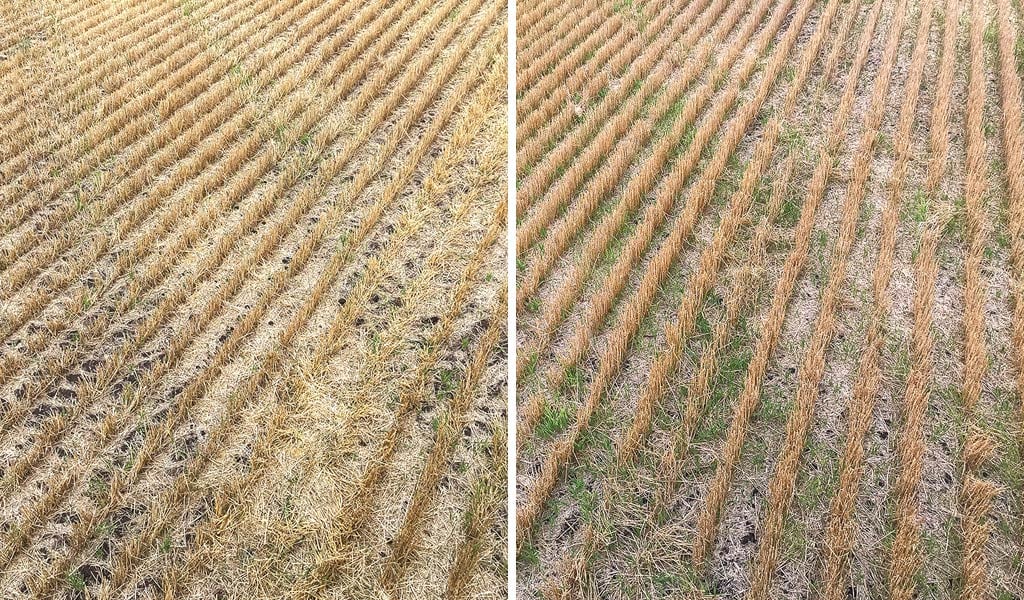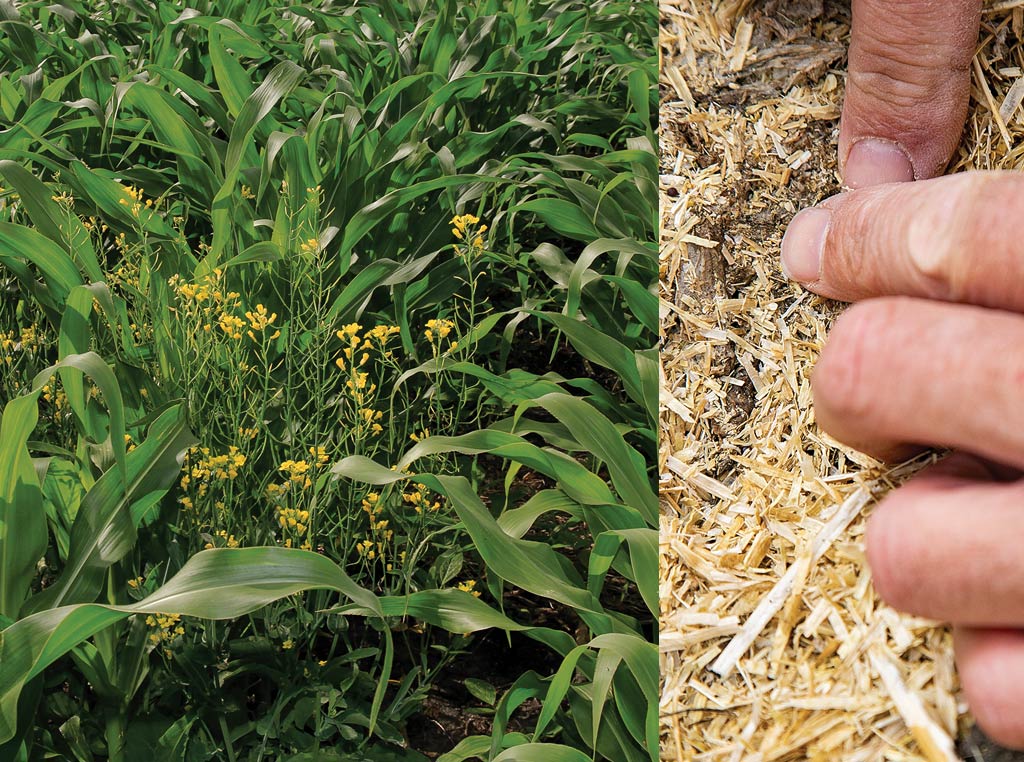
Rosh Lade and his partners, John, Janice, Rayden and Jenn Wiebe have been conducting a three year farm-scale test of the technology with two Seed Terminators they imported from Australia.
Agriculture, Farm Operation September 01, 2021
Beyond Herbicide
New ways to control resistant weeds.
Hey grandpa, tell us about the good old days when you were able to spray herbicides on your crops and they would kill weeds!
The war against herbicide resistant weeds hasn’t reached such an apocalyptic scenario yet, but it’s heating up, and the weeds are winning. Multiple species have developed resistance to at least one chemical group used to control them. Some, like Palmer amaranth and kochia have developed resistance to multiple modes of action including glyphosate, ALS inhibitors and dicamba. The evidence shows they can become immune to others too.
A Canadian study on herbicide resistant kochia, published in the February 2021 edition of the Canadian Journal of Crop Science, concluded that farmers had to proactively use integrated weed management techniques if they want to preserve their dwindling number of herbicide options. Some of the options suggested by the lead author, Alysha Torbiak, are: “including crops with alternative life cycles (winter-annuals or perennials), competitive crop cultivars, cover crops, field scouting, resistance diagnostic testing, strategic and site-specific tillage, and potentially also harvest weed seed control.”
“Herbicide resistance is just such a widespread and growing problem, and such a threat to our production agricultural systems, that it’s clear we need to look at non-chemical solutions, in concert with herbicides, as a way forward,” says Michael Flessner, an associate professor and weed science extension specialist at Virginia Tech in Blacksburg, Virginia. “I don’t think you could look at (what’s happening with) herbicide resistance and come to any other conclusion.”
Australian struggle. North American farmers just need to look to their Australian counterparts to see how bad it can be. The development of annual rye grass resistant to multiple modes of action (including glyphosate) has caused complete harvest losses in some fields. Producers were forced to adopt mechanical harvest weed seed control technology over the past 20 years to reduce resistant weed pressure.
Current generations of the technology mount onto the back end of the combine and directs the chaff coming off the sieves into a hammer mill. It pulverizes any weed seeds or volunteer grains seeds that are in the chaff before spreading the chaff across the width of the header cut. Research by Australia’s Herbicide Resistance Initiative (AHRI) has found these mills were very effective. They destroy up to 98 percent of any weed seeds or volunteer grains that are in the chaff.
But Australian harvest conditions are completely different than those in Canada and the U.S. So, Josh Lade and his partners, John, Janice, Rayden, and Jenn Wiebe decided to conduct a three-year farm scale test on their 16,000 acre, grains, pulses and oilseeds farm at Osler, Saskatchewan to determine if it could be an option in Canada. The partners imported two Seed Terminators (designed by Lade’s cousin Nick Berry), one in 2018, and a second improved one in 2019, and mounted them on two of their four S780 combines.
“It was quite dry in the fall and spring of 2019, so we didn’t notice much difference the first year,” Lade says. “Big differences showed up in the fall of 2019 when we harvested roughly half of our 16,000 acres with them; two combines had terminators and the other two didn’t. The differences were most pronounced in the malt barley fields where we were really pushing the combines due to an upcoming rain. Weeds and volunteer barley thrown over by the two combines without terminators showed up as alternating green stripes up and down the field in the satellite imagery. The difference was very noticeable; it’s almost funny when you are in the sprayer. There was loads of volunteer canola in one pass and almost none in the next pass where the combine had a mill.” They were so impressed they’ve purchased two more for the 2021 harvest.

There was little difference between combines the first year due to dry conditions, Lade says, but the following year the differences were striking. Weeds and volunteer barley from combines without mills left green stripes visible in satellite photos.
There are at least three combine-mounted mechanical harvest weed seed control systems on the market. Two, the Integrated Herrington Seed Destructor (IHSD) and the Seed Terminator, are made in Australia. The third, Redekop Manufacturing’s SCU, is made in Saskatoon, Saskatchewan. Almost all are sold in Australia.
Fighting weeds by reducing the seed bank is a novel practice in weed management (in North America), Flessner says. He launched a three-year harvest weed seed control study in 2020, using the Redekop SCU system, to see if this approach will work in the Mid-Atlantic states. While it’s too early to draw any firm conclusions, he says, the technology appears to offer a promising way to address herbicide resistance that could easily fit into current production systems here.

One key benefit, Thiessen says, is the technology lets producers eliminate herbicide resistant volunteers with their combine. Tests show the mills kill 98% of any seeds in the chaff stream.
Volunteers too. “It destroys almost all the weed seeds that go through the combine and also controls any volunteers at harvest, so it prevents all the problems herbicide resistant volunteers cause in subsequent crops,” says Trevor Thiessen, president and co-owner of Redekop Manufacturing. “We don’t see it as a replacement for all chemistry, or rotation, or tillage techniques, but it gives farmers a very simple tool they can bolt onto their combine. They don’t have to pull out their sprayer and do an extra pass; they don’t have to go out and run another piece of tillage equipment over their ground.”
“The mills keep the combine from spreading resistant patches of weeds across the field,” Lade says. “Let’s use wild oats as an example. Perhaps 80% to 90% of your wild oats will have dropped on the ground before harvest; only about 10% of the seeds will go into the harvester. But unless you have an absolute disaster on your hands your wild oats are going to be in patches and when they drop their seed on the ground they stay in those patches. But any of the harvested 10% that don’t go into the combine’s grain tank will be spread down the field in the chaff. The mills stop that though, so we can go in and treat the patches separately with a high dose of Avadex, targeted tillage or whatever.”
Harvest weed seed control units aren’t cheap. They sell for about CDN$100,000 (USD$75,000). But Lade says in their operation, where they harvest 4000 acres per combine, and plan to keep each mill for eight years, they price out in the CDN $5.00 to $10.00 per acre range after they factor in the purchase price, replacement parts and an extra dollar an acre in extra fuel to run it. He thinks if something came in a chemical drum that would reduce your most problematic weeds by 50% for $8.00 to $12.00 an acre, people would put it in their sprayer.
“I can’t express enough that they’re not a silver bullet, they’re not going to solve everything,” Lade says. “But we have to use these things now, before we find ourselves in a position where we’re really clutching at straws like the Australians were 20 years ago, when they couldn’t control annual rye grass with anything.” ‡
Read More

RURAL LIVING
Encounters With The Unexplained
Farmers share their personal ghost stories.

